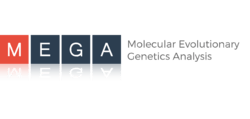MEGA, Molecular Evolutionary Genetics Analysis
|
Version 7 (2016) | |
| Original author(s) | Masatoshi Nei, Sudhir Kumar, Koichiro Tamura, Glen Stecher, Daniel Peterson, Nicholas Peterson |
|---|---|
| Developer(s) | Pennsylvania State University |
| Initial release | 1993 |
| Stable release |
7.0.14
/ January 2016 |
| Development status | Active |
| Operating system | Windows, OS X, Linux |
| Platform | x86, x86-64 |
| Available in | English |
| Type | Bioinformatics |
| License | Proprietary freeware |
| Website |
www |
Molecular Evolutionary Genetics Analysis (MEGA) is computer software for conducting statistical analysis of molecular evolution and for constructing phylogenetic trees. It includes many sophisticated methods and tools for phylogenomics and phylomedicine. It is licensed as proprietary freeware. The project for developing this software was initiated by the leadership of Masatoshi Nei in his laboratory at the Pennsylvania State University in collaboration with his graduate student Sudhir Kumar and postdoctoral fellow Koichiro Tamura.[1] Nei wrote a monograph (pp. 130) outlining the scope of the software and presenting new statistical methods that were included in MEGA. The entire set of computer programs was written by Kumar and Tamura. The personal computers then lacked the ability to send the monograph and software electronically, so they were delivered by postal mail. From the start, MEGA was intended to be easy-to-use and include solid statistical methods only.
MEGA version 2 (MEGA2), which was coauthored by an additional investigator Ingrid Jakobson, was released in 2001.[2] All the computer programs and the readme files of this version could be sent electronically due to advances in computer technology. Around this time, the leadership of the MEGA project was taken over by Kumar (now at Temple University) and Tamura (now at Tokyo Metropolitan University). The monograph Molecular Evolutionary Genetics Analysis was often used as a textbook for new ways to study molecular evolution.
MEGA has been updated and expanded several times and currently all these versions are available from the MEGA website. The latest release, MEGA7, has been optimized for use on 64-bit computing systems. MEGA is in two version. A graphical user interface is available as a native Microsoft Windows program. A command line version, MEGA-Computing Core (MEGA-CC), is available for native cross-platform operation. The method is widely used and cited. With millions of downloads across the releases, MEGA is cited in more than 85,000 papers. The 5th version has been cited over 25,000 times in 4 years.[3]
Release history
| Version | Release date |
|---|---|
| 1.0 | 1993[1] |
| 1.1 | 1994[5] |
| 2.0 | 2000[2] |
| 2.1 | 2001[2] |
| 3.0 | 2004[6] |
| 4.0 | 2006[7] |
| 4.1 | 2008[7] |
| 5.0 | 2011[8] |
| 5.1 | Oct 2012[8] |
| 5.2 | April 2013[8] |
| 6.0 | December 2013[3] |
| 7.0 | January 2016[9] |
Features
Sequence alignment construction
- Alignment editor
- Multiple sequence alignment
- Sequencer (trace) file editor-viewer
- Integrated web browser, sequence fetching
Data handling
- Handling ambiguous states: R, Y, T, etc.
- Extended MEGA format to save all data attributes
- Importing data from other formats: Clustal, Nexus, etc.
- Data explorers
- Visual specification of domains-groups
Genetic code table section
- Add-edit user defined tables
- Compute statistical attributes of a code table
- Include all known code tables
Real-time caption expert engine
- Generate captions for distance matrices, phylogenies, tests, alignments
- Copy captions to external programs
Integrated text file editor
- Columnar block selection-editing
- Line numbers
- Utilities to format sequences, reverse complement etc.
Sequence data viewer
- Data export
- Highlighting
- Statistical quantities estimation
MCL-based estimation of nucleotide substitution patterns
- 4x4 rate matrix
- Transition-transversion rate ratios: k1, k2
- Transition-transversion rate bias: R
Substitution pattern homogeneity test
- Composition distance
- Disparity index
- Monte-carlo test
Distance estimation methods
- Nucleotide-by-nucleotide
- Synonymous-nonsynonymous: codon-by-codon
- Protein distance
- Distance calculations
- Sequence diversity calculations
- Variance calculations
Tests of selection
- Large sample Z-test
- Fisher’s exact test
- Tajima’s neutrality test
Molecular clock test
- Tajima’s relative rate test
Tree-making methods
- Neighbor joining
- Minimum evolution method
- UPGMA
- Maximum parsimony
- Bootstrap phylogeny test
- Confidence probability test
- Distance matrix viewer
Tree explorers
- Phylogeny display
- Divergence time estimation
- Tree editing
- Change tree size
- Multiple tree display
External links
- Official website
- MEGA website for Japanese users
- MEGA: A biologist-centric software for evolutionary analysis of DNA and protein sequences. (2008) Kumar S, Dudley J, Nei M & Tamura K. Briefings in Bioinformatics Vol.9, pages 299-306
References
- 1 2 Kumar, S., K. Tamura, and M. Nei (1993) MEGA: Molecular Evolutionary Genetics Analysis. Ver. 1.0, The Pennsylvania State University, University Park, PA.
- 1 2 3 Kumar, S., K. Tamura, I. B. Jakobsen, and M. Nei (2001) MEGA2: Molecular Evolutionary Genetics Analysis. Ver. 2.0, Bioinformatics 17:1244-1245.
- 1 2 Tamura, K., Stecher, G., Peterson, D., Filipski, A., Kumar, S. (2013) MEGA6: Molecular Evolutionary Genetics Analysis Version 6.0. Mol. Biol. Evol. 30:2725-2729.
- ↑ "MEGA Update History". MEGA: Molecular Evolutionary Genetics Analysis. Retrieved 20 June 2013.
- ↑ Kumar, S., K. Tamura, and M. Nei (1994) MEGA: Molecular Evolutionary Genetics Analysis software for microcomputers. CABIOS 10:189-191.
- ↑ Kumar, S., Tamura, K., and Nei, M. (2004) MEGA3: Molecular Evolutionary Genetics Analysis. Brief. Bioinformatics 5:150-163.
- 1 2 Tamura, K., Dudley, J., Nei, M., Kumar, S. (2007) MEGA4: Molecular Evolutionary Genetics Analysis. Mol. Biol. Evol. 24(8):1596-1599.
- 1 2 3 Tamura, K., Peterson, D., Peterson, N., Stecher, G., Nei, M., Kumar, S. (2011) MEGA5: Molecular Evolutionary Genetics Analysis using Maximum Likelihood, Evolutionary Distance, and Maximum Parsimony Methods. Mol. Biol. Evol. 28:2731-2739.
- ↑ Kumar, S., Stecher, G., & Tamura, K. (2016). MEGA7: Molecular Evolutionary Genetics Analysis version 7.0 for bigger datasets. Molecular biology and evolution, msw054.
